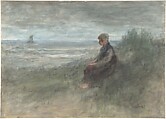Girl in the Dunes
Jozef Israëls Dutch
Not on view
Israëls was one of the most important artists of the Hague School, a term coined by a critic in 1875 to describe a group of artists working in a new realist manner. Like the Post-Impressionists, these artists shared friendships more than common artistic purpose. This beautiful watercolor of a girl looking out to sea was inspired by the impoverished fishermen and their families whom Israëls first encountered in 1855 at Zantvoort and Katwijk. The simplicity of the composition ennobles this girl and creates a melancholy mood. The drawing recalls Millet's sympathetic representations of peasants, which Israëls would have known from his trip to Paris and Barbizon in 1853.
In Israëls's portrayal of the poor families of fishermen, Van Gogh found the same sympathetic dignity that characterizes Millet's peasant farmers. "When Israëls, or, say, Daumier or Lhermitte, draws a figure," Vincent wrote Theo (in July 1885), "one gets much more of a sense of the shape of the body, and yet . . . the proportions will sometimes be almost arbitrary, the anatomy and structure often anything but correct in the eyes of the academicians. But it will live." Colta Ives
Due to rights restrictions, this image cannot be enlarged, viewed at full screen, or downloaded.



